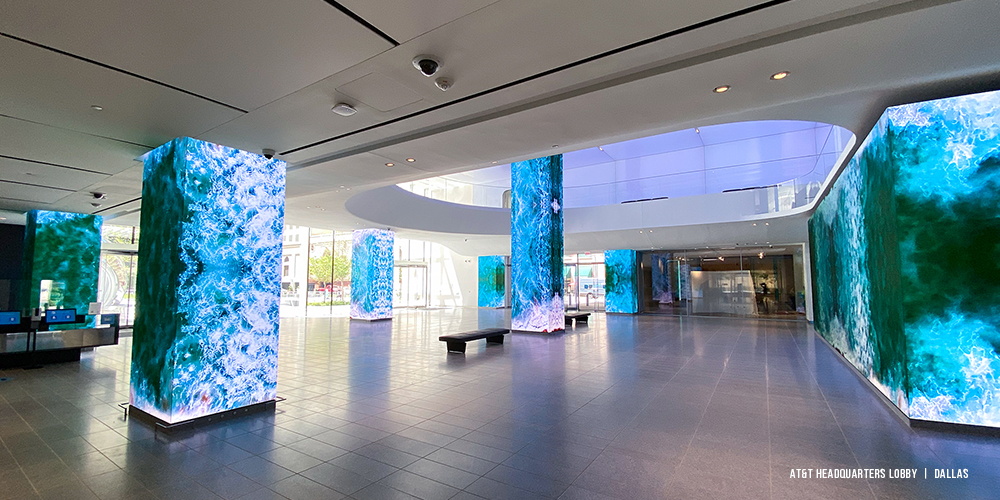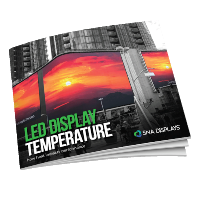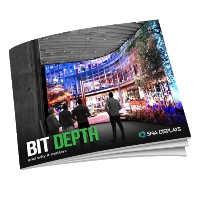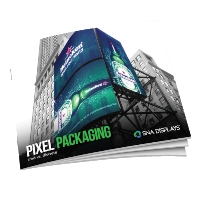“It’s what you learn after you know it all that counts,” is the famous quote from renowned basketball coaching legend John Wooden. And that same logic applies to digital signage and any other video display application. To that end, Paul England, CTS, Director, Design Solutions for SNA Displays, addresses 5 key questions for integrators regarding important considerations ranging from brightness levels to pixel pitch to outdoor applications.
 1) Is there a formula which integrators should use to determine the brightness and size of a display in a digital signage or corporate boardroom scenario?
1) Is there a formula which integrators should use to determine the brightness and size of a display in a digital signage or corporate boardroom scenario?
Designing the ideal solution for a boardroom—or any installation—often requires a great deal of planning, design, and engineering. The first step is to determine how high the screen will sit above any furniture, such as a conference table, to ensure that all potential meeting participants have clear sightlines. From there, it is important to calculate a height and pixel pitch that yields a typical resolution like 1080p, 1440p, or 4K for easier connectivity to various computers. One quick shortcut for determining the height of a display is viewing distance divided by eight. For example, a display that will be viewed up to 24 feet away should be at least three feet in height. The “8x ratio” works well for standard video, but we suggest reducing the factor to perhaps as little as four for viewing small text such as technical data.
Likewise, determining brightness entails measuring or estimating the ambient light during typical usage times. For example, are there south-facing windows? When in doubt, use a photometer to capture the actual ambient light to determine the brightness. For installations that will be viewed under a wide range of light conditions, it’s simple to schedule brightness by time of day or use an ambient light sensor to make adjustments automatically.
2) What are some of the key technical considerations for outdoor digital signage compared to indoor?
Outdoor digital signage is substantially different from indoor technology in several ways. The major difference is the IP (ingress protection) rating. An indoor display may be IP41- to IP54-rated, meaning from relatively unsealed to virtually sealed from dust and splashes of water. IP ratings for outdoor displays are usually IP65 or IP68. IP65-rated displays are sealed against weather and even direct jets of water (e.g., spray-washing), whereas IP68-rated digital signage should remain operable after being submerged in water. Very few applications actually require an IP68 rating.
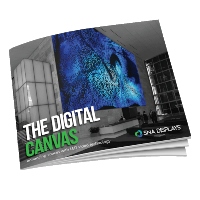 Another significant difference is brightness. A typical indoor display may run at 500 to 1,500 nits of brightness, while an outdoor display is much more commonly run at 4,000 to 7,500 nits. (Nit is a measurement of brightness equal to one candela per square meter (1cd/m2). That’s right – when you break it down, the industry is still measuring brightness with candles!)
Another significant difference is brightness. A typical indoor display may run at 500 to 1,500 nits of brightness, while an outdoor display is much more commonly run at 4,000 to 7,500 nits. (Nit is a measurement of brightness equal to one candela per square meter (1cd/m2). That’s right – when you break it down, the industry is still measuring brightness with candles!)
Additionally, there are mechanical considerations when it comes to indoor vs outdoor digital signage. An outdoor display is subject to adverse weather like rain, snow, high winds and more. These conditions may necessitate a much stronger structure.
3) What is pixel pitch and how should an integrator explain it simply to their clients?
Pixel pitch is the distance from the center of one cluster of diodes (a pixel) to the center of an adjacent pixel, typically measured in millimeters. A smaller number indicates less distance between pixels, thus a higher density of pixels. It’s worth noting that halving the pixel pitch doesn’t translate to twice as many pixels but rather four times as many pixels, because both the horizontal and vertical dimensions are doubled.
Prime considerations for choosing the right pitch for an application include the expected content, the planned budget, meeting a standard resolution like 1080p, the physical size of the display, and the optimal viewing distance. A decent rule of thumb is to convert millimeters of pixel pitch into meters of distance, meaning a display with a 4 mm pixel pitch will look good to a viewer about 4 meters away. However, while this rule normally has good results, it is far from “golden.” In fact, designing for the intended content, application, or budget is arguably as important than viewing distance, if not more so.
4) How should integrators plan for weight, heat, power and other physical factors in a digital signage deployment?
Integrators must visit the site to determine power and data availability as well as pathways. A structural review should be done to ensure the structure can support the additional weight of the mounted display. Depending on the display’s location, a rough heat load calculation, at minimum, should be performed to ensure the existing or planned HVAC can manage the expected heat output. Furthermore, integrators should the available power at the panel and reserve power to determine whether additional power is needed. The display manufacturer can compute this data and make it available to the integrator during the design review stage.
5) What are the advantages of all-in-one packaged solutions from an installation, design and inventory management standpoint for commercial AV integrators?
The most significant advantages of all-in-one LED display solutions are simplicity and cost-effectiveness, as these products more readily available in commonly requested sizes and resolutions. This makes for rapid, relatively inexpensive deployments. These display products are typically simple, with setup instructions much like that of a large consumer TV; some are even plug-and-play with one cable for data and one for power. That said, all-in-one solutions aren’t a panacea; many applications are better served with custom-designed and engineered solutions, tailored to application requirements.
SNA Educational Resources
Understanding Pixel Pitch
Pixel Packaging
Bit Depth
LED Display Temperature
The Digital Canvas

